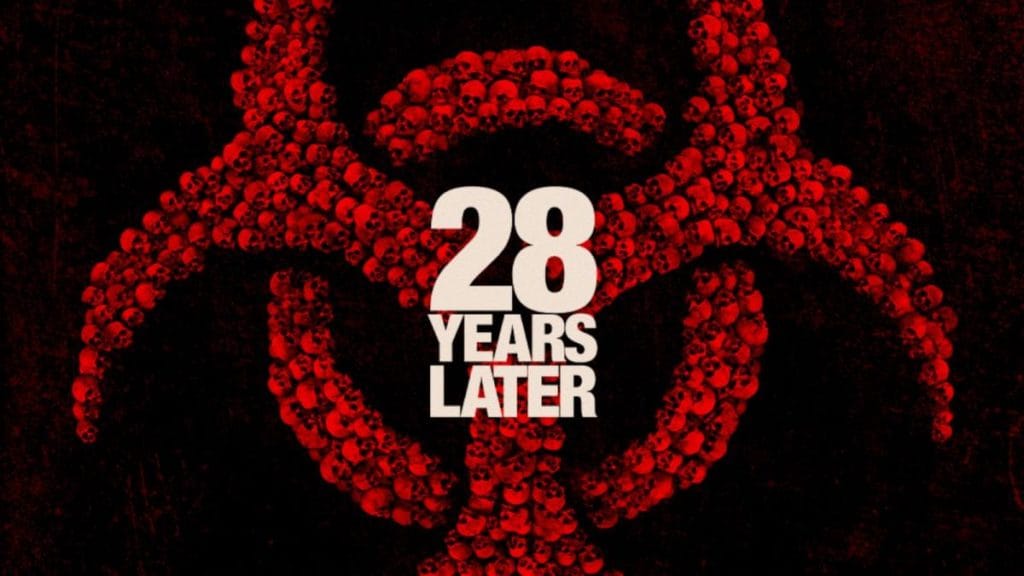
[Credit: Columbia Pictures]
It’s been some time since I’ve had a difficult film to review, but 28 Years Later, surprisingly, is that movie. After a knockout trailer and the knowledge that director Danny Boyle and writer Alex Garland would be reviving their not-zombie franchise, I was understandably very excited. But the movie wasn’t quite what I was expecting, and I had some trouble pinning down certain elements of the film.
Set some 28 years after the Rage Virus is set loose on the U.K., people have reverted back into a more primitive hunter/gatherer society. We hone in on one such community, who live on a fortified island off the coast, which is protected by a causeway that comes and goes with the tide. It’s here where we meet Spike, a 12-year-old kid who is about to leave the safety of the island for the first time to go hunt infected with his dad, Jamie. Spike’s mother is unfortunately unwell, but does not approve of Spike leaving the fort at his young age. But the pair do head out despite the risks and his mother’s wishes.
[Credit: Columbia Pictures]
And that’s as vague as I’ll have to keep it for the story, leading me to think that I’ll likely have to do a spoiler review for 28 Years Later to properly dive into it. But let’s talk about what does work. All the actors in this one are great. Aaron Taylor-Johnson as Jamie is putting on a great performance as the patriarch of the family, and Jodie Comer is excellent as Isla, an ailing mother. There’s also Ralph Fiennes’ Kelson, who shows up later in the movie, and while his screentime is minimal, he is still magnetic to watch. But the MVP of the movie is Alfie Williams as Spike. This kid crushes it. I have no idea if he wants to make a career of acting, but if he does, he has a bright career ahead of him. He puts on an emotionally charged performance, and his character arc is really compelling. There’s plenty of youthful hope and fear, that sense of being over one’s head, and seeing the world beyond its simple black and white trappings. The themes of life and death permeate throughout the film, and seeing them through the eyes of a kid really helps sell the story.
[Credit: Columbia Pictures]
From a production standpoint, it’s a bit mixed. The locations are all stellar, from the isolated community Spike is from, to the mossy forests on the mainland, to old towns and churches. The Bone Temple, as seen in the marketing, is also quite impressive, in its own eerie way. The film was shot using modified iPhone 15s (with a whole bunch of expensive lenses), and the results are mixed, I would say. It looks great using medium to long shots, but I found the image would fall flat using close-ups. Specifically noticeable was that the depth of field looked really off in some instances (but looked okay in others). I’m not sure if that’s due to lighting or settings for the phones, but it was noticeable to me. There’s also some weird style choices, such as these weird snap-cuts during some archery scenes, where the camera would snap 90-180 degrees to where it was before. I found it didn’t add anything to the movie beyond being a little jarring and distracting. But a red filter when seeing the world from the perspective of the Infected was an eerie and effective style choice. 28 Years Later is also by far the gnarliest film in the franchise, so mental note for the squeamish.
BTS on ’28 Years Later’ [Credit: Columbia Pictures]
Despite the film being way more violent than its predecessors (and that’s saying something), 28 Years Later is a film that’s lacking in tension and horror, which is a cardinal sin, I’d say. There’s no scenes that got the heart pounding with fear and dread, akin to the tunnel scene in 28 Days, or the night vision scene in Weeks. I also would have liked to have seen a bit more of the world. Considering the franchise and where the Infected are at now, some thirty years later, it does feel like a missed opportunity. Thematically, the film deals with themes such as isolationism and nationalism, taking clear inspiration from the COVID-19 pandemic and Brexit, while also not really exploring those themes properly. Death, and by extension life, are more blatant themes, but there’s no real room for interpretation or nuance for them.
[Credit: Columbia Pictures]
Now I can’t get into specifics, but the ending of this movie is weird. Not only because of the drastic and bizarre tonal shift, but because it comes out of nowhere and isn’t really explained very well. I had to do a bit of research on the ending and did find quite a bit of context that helped explain things to us non-British audience members. But even with that context, the scene is still incredibly jarring and out of place in terms of style, tone, and editing. There is going to be a second installment coming in January titled 28 Years Later: The Bone Temple, that will hopefully provide some context and answers to the unresolved plot points, but the ending was certainly a choice and if I had to research context for the ending, I’m not sure it’s doing a good job as both closure to the story and/or setting up the next installment.
[Credit: Columbia Pictures]
In the end, I’d say 28 Years Later is still a good film, it’s just not a great one. It’s one that’s enhanced by the performances of its cast, but dragged down a bit by its script. Time will tell if the story ages well when further stories get released.







